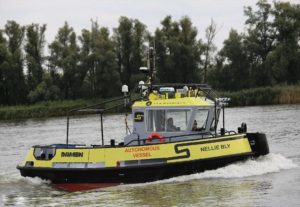As the tugboat Nellie Bly circumnavigated Denmark, engineers and a remote crew kept an eye on the vessel from a control room in Boston. A 4G connection provided the internet connectivity. These videos bring you into the control room.
Autonomous sea vessels show promise as the next step in water navigation. Of course, such vessels must prove themselves capable of operating safely. They must reach their destinations while avoiding collisions with dry land, other vessels, buoys, whales, and the bottom.
Boston-based Sea Machines has developed a control system for autonomous vessels. In a trial, the company recently installed its equipment in the tugboat Nellie Bly (Figure 1), which circumnavigated Denmark on a 1000 nautical mile journey in October 2021. Part of that trip took the Nelly Bly through the Kiel Canal in northern Germany (Figure 2).
As a precaution, a two-person crew was on the vessel while another crew monitored the vessel’s program from a control room at Sea Machines. The onboard crew never intervened during the voyage. The Boston-based remote crew did. 5G Technology World visited the Boston control room during the trip to get a look at the action and learn how the vessel communications with the remote crew.
Located across Boston Harbor from the USS Constitution, Sea Machines develops software used to control vessels. Working with partners, the company also provides the hardware used for both remote and onboard human control of engine RPM, speed, and course.
Video 1 provides an overview from the control room. There, Adam Szloch (USCG Chief Mate, Unlimited Tonnage) and Bridget Quinn (USCG Second Mate, Unlimited Tonnage) explain what we saw from video cameras onboard the vessel. The video also shows maps and plots of the vessel’s location and course.
In Video 2, Szloch explains how the vessel “learns” to avoid anything if it’s path. It needs to identify the horizon, ships, buoys, dredges, and other obstacles.
The video cameras and remote-control systems communicate to the control room over an LTE network. Two LTE modems, connected to different cellular networks, provide more data flow than one modem. The two modems provide redundancy should one lose connectivity on one network. Clearly, the vessel must stay within cellular range of shore, which was 11 km. From the cellular network, the vessel connects to the Boston control room over the public internet. The overall data rate varied from 6 Mb/sec to 20 Mb/sec, which was sufficient to keep up with the video streams.
Because the Boston crew needed to assume control of the vessel during the voyage, you might think that network latency was an issue. After all, we hear about how latency in 5G will improve remote control in factories and other locations. In this application, network delay was well within that needed to control the vessel. Sea Machines didn’t provide latency numbers. According to Sea Machines director of engineering Alex Venetiou, “Latency did not present an issue while the system was under manual control.”
Venetiou explained how onboard computers provide autonomy including collision avoidance, viewing the planned mission, low-level control for the vessel’s propulsion, steering, and ingesting all the sensor data. The vessel’s sensors include a GNSS satellite compass for position and heading as well as sensors the wind direction and speed. An Automatic Identification System (AIS) lets the vessel receive information from other vessels with AIS. Radar also play a role in detecting targets.
In addition to developing the control software for the Nellie Bly, the company provides a Wireless Helm Control system that let the Boston or onboard crews control the vessel. In Video 3, Venetiou and senior controls engineer Chris Spagna explain how the system works and how it connects to off vessel over an EU-approved 870 MHz link.
The Nellie Bly voyage demonstrated that autonomous water navigation is possible. It will continue to improve as the machine learning better identifies other types of vessels and obstacles. Sea Machines didn’t mention any detection of ocean life such as whales, but that could come later.








